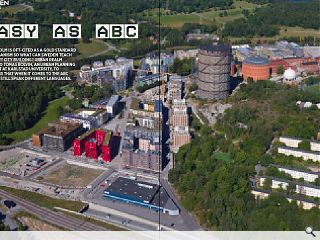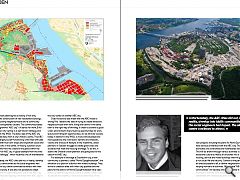Sweden: The ABC City
21 Oct 2019
Stockholm is oft-cited as a gold standard for urbanism so what can Sweden teach us about city building? Urban Realm turns to Tomas Bolvin, an urban planning student at Karlstad University, to discover that when it comes to the abc city we still speak different languages.
In Sweden, urban planning has a history of not only focusing on the construction of new residential buildings, but also on building neighbourhoods and a community for active and enlightened citizens. The community-based planning programme” ABC city” (A stands for work, B for living and C for city-centre) is a well-known strategy and was popular in the 1950s. The basic idea of the ABC city was to be build away from a city’s historic centre. The ABC-cities would largely be self-functioning units filled with jobs and housing with their own shops and important social and cultural functions in the centre. In theory, a person could live a decent life from the cradle to the grave within the boundaries of an ABC city. A good example from this time is the town “Vällingby”, which received a lot of international attention.
Unfortunately, the ABC cities did not, in reality, develop into the idyllic communities as the social engineers had hoped. The old city-centre continued to attract with their history and diversity. It was also not possible to adapt workplaces with the right manpower within the ABC city, which led to many facing long commutes from ABC city to the city-center or another ABC city.
Does the above idea mean that the ABC model is wrong? No. I believe the idea of trying to create attractive neighbourhoods with work, living and centre in the same town is the right way of thinking. In order to achieve a good urban environment, there must be opportunities for work, leisure and transport opportunities. As we all know society today in relation to the 1950s, is more individualized and more guided by the individual’s demand and interests, visions and choices of lifestyle. In the meantime, urban planners in Sweden struggle to create good cities and societies that meet the housing shortage. To do this, it seems like Swedish urban planners are going back to the idea of the ABC city.
For example in the edge of Stockholm city, a new community is planned, called ”Norra Djurgårdsstaden”, the ambition is to plan for a district with mixed buildings. They strive to create an area with inner-city qualities and the plans for the district of Norra Djurgårdsstaden have been drawn up with the keywords; Dense, Durable, Urban, Safe, Accessible and Identity. I have noticed that many of the new projects including the plans for Norra Djurgårdsstaden have obvious similarities with the ABC-city. That is, one advocates one diversified and multifaceted neighbourhood. This will be shown through various activities such as trade and culture as well as a functional mix of work, housing, service and mixed buildings that will generate a rich social life and security. Central to the planning is an area accessible to all, a vibrant neighbourhood with varying numbers of activities. What these “ABC influenced communities” will develop into is impossible to say, but my belief is that the main focus needs to be on dense settlement with varied style and function.




